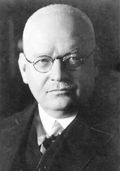From 1897 Hans Luther studied law at Kiel, Geneva and Berlin, and became a civil officer in Berlin. From 1907 to 1913 he worked in the Magdeburg municipal council. In 1913 he received a job as executive member of the board of the German Städtetag, but left the service to become mayor of Essen in 1918. Staying out of any party's membership, Luther served as minister of food (1 Dec 1922 - 6 Oct 1923) in the cabinets of Wilhelm Cuno and Gustav Stresemann. In the second government of Stresemann and two cabinets of Wilhelm Marx, Luther held the office of finance minister (6 Oct 1923 - 15 Jan 1925) and succeeded in measures for stabilization of the inflated national currency. The third Reichstag dominated by the Social Democratic Party, the National People's Party (DNVP) and the Catholic Centre Party, approved the appointment of Luther as Reich Chancellor on 15 Jan 1925. He formed a five-party cabinet and on 28 Feb 1925 assumed the duties of Reich President after the death of Friedrich Ebert. He served in this capacity until Walter Simons became Acting Reich President on 12 Mar 1925 according to the law enacted by the Reichstag. Luther also temporarily assumed the portfolio of finance minister (from 26 Oct 1925) after DNVP left the ruling coalition. He supervised the signing of the Locarno Pact by Germany (December 1925) and resigned shortly thereafter. He was recalled (19 Jan 1926) and formed a minority cabinet (People's Party, Democratic Party, Catholic Centre Party), which did not survive a no-confidence vote in the Reichstag on 12 May 1926 over the use of a modified imperial flag for representation of Germany abroad. In 1926-1928, Luther was a member of the Board of the Deutsche Reichsbahn. In March 1930 he succeeded Hjalmar Schacht as president of the Reichsbank, and in 1933-37 he was German ambassador to the United States. Biography source:
Akten der Reichskanzlei: Weimarer Republik. Die Kabinette Luther I und II (Boppard am Rhein: Harald Boldt Verlag, 1977);
"Weimar, 1918-1933 : die Geschichte der ersten deutschen Demokratie", ed. by Heinrich August Winkler (München: Beck, 1993).;
"Dokumente zur deutschen Verfassungsgeschichte", ed. by Ernst Rudolf Huber (Stuttgart: W. Kohlhammer, 1961-1966)..
|

